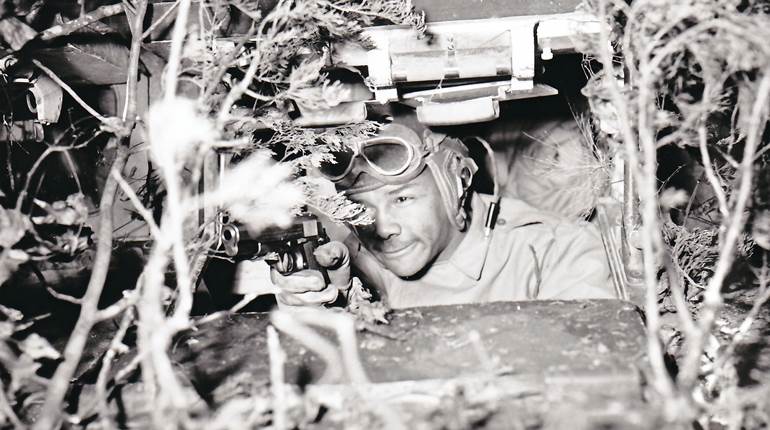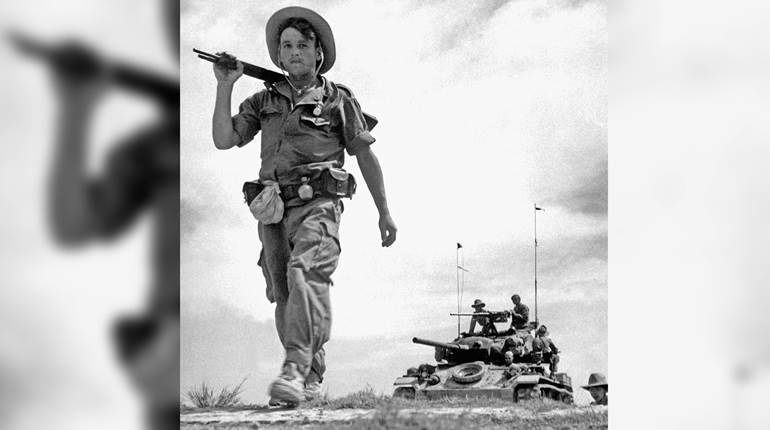
A half-century ago, the North Vietnamese People’s Army (NVA) and Viet Cong launched the Tet Offensive across South Vietnam. Shown here is an NVA trooper armed with a Chinese Type 50 SMG, on which the K-50M is based.
During the Vietnam War, American troops discovered a wide range of Communist-Bloc small arms in service with the Viet Cong and North Vietnamese armies. One of the more interesting and little-known firearms used during the conflict—but well-remembered by many American veterans of the Vietnam War—is the North Vietnamese K-50M submachine gun. It represented the Vietnamese ability to modify and locally produce effective infantry arms in simple cottage workshops. The K-50M used the Soviet PPSh-41 (produced by the Communist Chinese as the Type 50 SMG), chambered in 7.62x25 mm Tokarev, as the basis for the home-built submachine gun. North Vietnamese and Viet Cong gunsmiths shortened the barrel jacket of the Type 50 and installed a more advanced front sight. The wooden buttstock was replaced by a combination pistol grip and retractable metal wire shoulder stock. It is a handy little submachine gun, well-suited to the needs of a Viet Cong guerilla.
Technical assessments from the wartime NVA or VC are rare, but I do have an ace up my sleeve when it comes to small arms of the Vietnam War. His name is Capt. Dale Dye, USMC (Ret.), a veteran of three tours of duty in Vietnam, who is well-known as an actor and technical advisor in military-themed Hollywood movies. He once told me “I’ve either fired or been fired upon by almost every firearm used in the Vietnam War.” When I asked him if he had any specific memories of the Vietnamese K-50M, he shared this story, a personal encounter with a little-known submachine gun:

“The first time I saw a K-50M submachine gun was the morning after a fight we had north of Quang Tri in late 1967. Moving through relatively heavy bush, we stumbled into an enemy unit moving in the opposite direction. It was what the manuals call a ‘meeting engagement,’ but it rapidly turned into what we more commonly referred to as a ‘goat-screw.’ It was late afternoon when the shooting started, and both sides burned a lot of [ammunition] through the night trying to break contact. I found myself among a couple of other Marines out on a flank where we were facing a small unit that kept probing for a hole in our defensive perimeter. One of the bad guys out there in the dark kept ripping away with a weapon that sounded different to our ears that were attuned to the sharp crack of the bog-standard AK. It had more of a ‘pop’ or ‘zip,’ and fired at a very high rate.
“The next morning when we swept the area we found a bunch of bodies and blood trails as usual, but I was interested in the guy we’d been trading rounds with during the night. He’d stopped firing a couple of hours before dawn, and I wanted to see if we’d managed to get him or he’d just decided to quit the fight. We found a dead VC trooper about 30 meters from our night position lying in a pile of expended brass. We rolled him over to discover a weapon that none of us had seen previously. I had seen enough movies to recognize that the guy’s gun had something in common with the Soviet PPSh-41. An S-2 scout with our unit identified the gun as a Vietnamese K-50M, that he said was a knock-off of the Chinese Type 50, which was based on the Soviet version. Other Marines sweeping the area found two more of them, and naturally we all got interested in this new discovery. The K-50Ms we’d faced during the fight had done a fairly good job of fire support and suppression for the VC. We couldn’t identify any of our wounded as being hit by the 7.62x25 mm, but the gunners had been highly mobile and effective in keeping us busy during the night. We detected a fair-size muzzle flash, but the K-50M gunners rarely fired twice from the same position and were hard to hit.

“The guns we recovered were relatively crude in construction, but the guts worked slickly and the 30-round magazines appeared to be reliable. Sometime later, I dropped by the ordnance section of the regimental S-2 to see what the tech-intel guys had to say about the K-50M and discovered that another unit had attacked and overrun a main force Viet Cong weapon factory in the area, which was apparently infamous for making or modifying the K-50M. One of the techs showed me some pictures of the little jungle workshop that included some surprisingly sophisticated tools. He also showed me some other captured K-50Ms that were significantly less well-made. Some had flimsy wire collapsible stocks and others had crudely carved wooden buttstocks. His opinion was that, since the factory had been destroyed, we’d likely see fewer of the K-50Ms in future engagements with local VC units. That turned out to be the case.
“Through 1968 I can only recall seeing two or three other models on various battlefields from the DMZ down to the southern limits of I Corps. By that time, we were mainly facing fresh in-country NVA units, and they usually fought with more standard infantry armaments, but other veterans I’ve met who fought mostly main force VC units tell me the K-50M was a common encounter in their areas of operations.”


 Small Arms Of The Vietnam War
Small Arms Of The Vietnam WarResearcher and frequent contributor Tom Laemlein and Capt. Dale Dye, USMC (Ret.) collaborated on Small Arms Of The Vietnam War: A Photographic Study, which is available in both hard copy ($35) and digital editions ($15) at bookstores or from medium.com. The 222-pp. book covers the small arms used during the conflict by both sides through photographs of all the arms in the hands of the troops who used them. It is broken down by type (handgun, rifle, shotgun and machine gun), and by those who carried them (Americans, Australians, South Koreans, Army of the Republic of Vietnam). There are more than 40 pages devoted to the arms used by the Viet Cong and North Vietnamese Army.




































